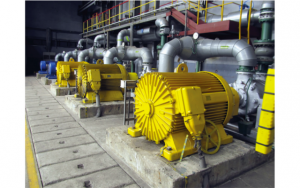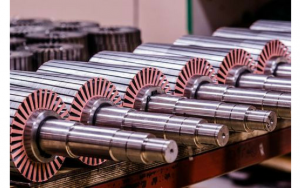Authors: Ettore Di Pasquale, Field Engineer partner of EasyTool, and Richard Scott, General Manager, ALL-TEST Pro, LLC.
Easy Tool, a Condition Monitoring Solutions Provider in Italy, works with a paint production facility in Ancona, a city along Italy’s Adriatic coast. This paint producer has worked with Easy Tool since 2013, relying on their highly knowledgeable field engineers to perform regular condition monitoring services for the motors, fans, pumps, and mixers operating in their paint production facility.
Every six months, field engineers from Easy Tool spend 6 days at the paint production facility, using a variety of technologies to test their equipment, perform vibration analysis, oil analysis, and motor testing as part of their preventive maintenance program. In January 2017, Ettore Di Pasquale, Field Engineer, was performing a dynamic test on a 55-kilowatt, 4-pole motor at the paint production facility when he discovered a significant current imbalance.
The Application
This 55-kilowatt, 4-pole motor was driving a fan that sucks solvents from the air of the paint production department. This fan is critical for ensuring worker safety. If the fan stops running, the paint producer must stop the production process. For this reason, this critical fan and motor are tested every six months to ensure uptime.
The Discovery
The fan is comprised of an impeller keyed directly to the motor shaft, which is controlled by a variable frequency drive (VFD). Di Pasquale used the ALL-TEST PRO On-Line II™ energized motor testing instrument to test the fan motor and discovered significant current imbalance at the VFD input and output (see Figure 1 and 2).
“Testing showed a current imbalance of 12.4% at the input of the VFD that became 74.8% at the output of the VFD,” explains Di Pasquale. “This is not
good for the motor – the VFD should supply the fan motor with balanced current. Given such high levels of current imbalance and the absence of several input half-waves, it became clear to me that the motor and fan were fine, but that the VFD needed to be replaced.”

Figure 1. Measurements taken at the VFD input show an abnormal waveform. This waveform shows how the current coming into the VFD is unbalanced. For example, the straight lines from the 15 second mark to the 23 second mark are flat – which means the VFD is not receiving any current. This waveform is not normal for a healthy VFD (a normal waveform at VFD input should look like the waveform in Figure 3).

Figure 2. Measurements taken at the VFD output show significant imbalance that exists in the current fed to the motor. As you can see, the green waveform (phase 2) should be similar in shape to the blue (phase 1) and pink (phase 3) waveforms, but it is drastically different. This waveform is not normal for a healthy VFD (a normal waveform at VFD output should look like the waveform in Figure 4).
Di Pasquale discussed the issue with the owner of the paint production facility. He explained that this current imbalance was likely a result of an internal problem with the VFD and recommended the VFD be replaced. Even though the fan could operate with this VFD-driven motor, the motor would eventually become damaged as a result of the current imbalance.
The Solution
Trusting Di Pasquale’s recommendation, the paint producer had the VFD removed and confirmed that there had been serious damage to the VFD’s internal diodes. The paint producer ordered a new VFD and was able to maintain production while waiting for the new inverter, which took 10 days to arrive. After the new VFD was installed, Di Pasquale went back to the facility to test the fan motor with the new VFD. The second round of energized motor testing with the ATPOL II™ showed healthy waveforms (Figure 3 & 4).

Figure 3. VFD input measurement following replacement.

Figure 4. Output measurement of new VFD (all three current waveforms are normal).
Lessons Learned
Even though the fan motor had a 74.8% current imbalance, no alarm or malfunction warning had been triggered. While the VFD seemed to be functioning properly, if allowed to continue running with faulty diodes, it could have failed abruptly – which would have brought the entire production department to a halt. This paint producer essentially prevented failure of the fan motor, ensuring worker safety and avoiding lost production and the related downtime expenses.
It is important to regularly check the health of your critical machinery. There are easy-to-use portable instruments, like the ALL-TEST PRO On-Line II™ energized motor testing instrument, that can help you check the condition of your motors. When you know what is really happening with your equipment, you can make smart decisions to keep people safe and to keep your operation running smoothly.
Watch this video to learn how motor testing can save you time, money, and headaches, or visit www.alltestpro.com for more information.
About ALL-TEST Pro LLC
Since 1985, ALL-TEST Pro, LLC has provided industry with the most advanced predictive maintenance testing and troubleshooting tools for AC and DC motors, coils, windings, transformers, generators and more to a wide range of industries worldwide. With a full line of testing instruments, software, accessories and training programs, ALL-TEST Pro has the tools you need to perform advanced non-destructive motor testing and analysis for both de-energized motor circuit analysis and energized electrical signature and power analysis. The extensive capabilities of the instruments, coupled with dependable post-sale training and technical support, ensure improved productivity, reduced downtime and a rapid return on investment.
About Easy Tool
Easy Tool distributor of ALL-TEST Pro, LLC for the Italian territory provides technical service, support, and training in condition monitoring practices and offers a wide product range, from high-tech portable instruments to online systems and a comprehensive condition monitoring software. To learn more, contact info@easytool.it.




